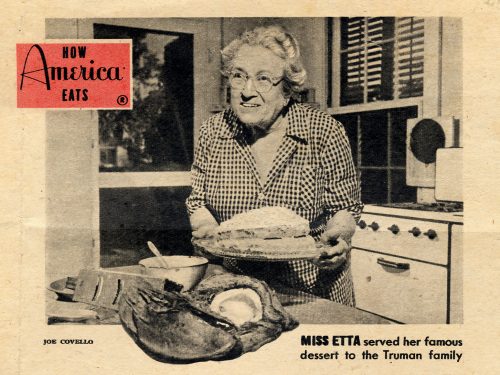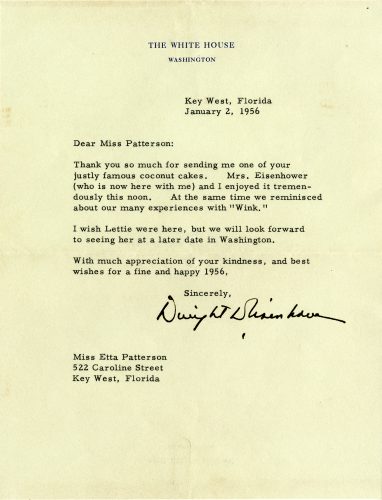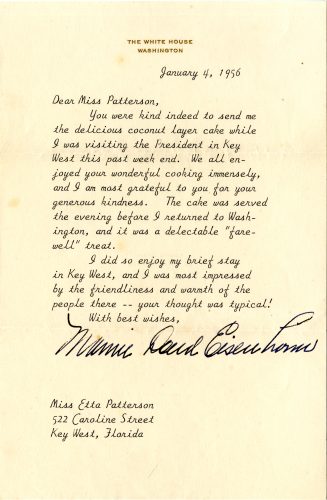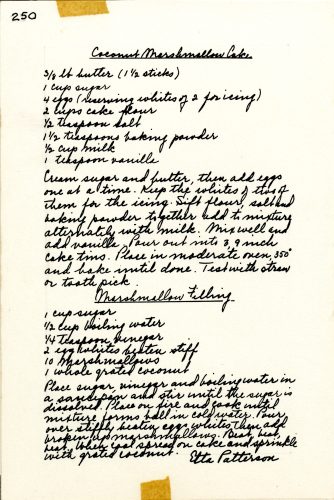Island Chronicles, vol. 13: Miss Etta’s Coconut Cake
Welcome to “Island Chronicles,” the Florida Keys History Center’s monthly feature dedicated to investigating and sharing events from the history of Monroe County, Florida. These pieces draw from a variety of sources, but our primary well is the FKHC’s archive of documents, photographs, diaries, newspapers, maps, and other historical materials.
By Corey Malcom, PhD
Lead Historian, Florida Keys History Center

Miss Etta Patterson with cake from ‘How America Eats,’ February 22, 1953.
Ask any resident or tourist in the Florida Keys what the leading local dessert is, and they will almost certainly tell you it is key lime pie. And today that is true; the citrus-based pie can be found in just about every restaurant across the islands, and there are even shops devoted entirely to it. But for a period, particularly in the 1940s and 50s, coconut cake was considered the symbolic local dessert. And a coconut cake baked by Etta Patterson was the most highly regarded of all. When a culinary writer visited Key West around that time and inquired about key lime pie, all the local cooks suggested coconut cake instead. “Coconut cakes are thirteen to a dozen,” she scoffed. “Not Miss Etta’s,” was the reply.
“Miss Etta” was Etta Patterson, born March 24, 1880; an island icon descended from one of Key West’s oldest families. Her grandfather was Alexander Patterson, who had settled on the island in 1828. He built a home at what is now 522 Caroline Street and quickly became one of Key West’s leading citizens. Etta’s father was George Browne Patterson, U.S. District Attorney under four presidents and later a judge. Etta’s mother Ida was the daughter of Winer Bethel, a native of the Bahamas who came to Key West in 1847. Etta’s Key West roots were as deep as could be.
In childhood, Etta’s singing talent emerged: “A beautiful lyric soprano voice, with a bird-like natural trill,” said one observer. Etta attended school at Mary Immaculate, and after graduation she went to New York to study at the Metropolitan Opera School. She performed at various venues in the city, but when her mother died in 1906, her time north was cut short. Etta returned to Key West to help care for her father and siblings.
Etta Patterson never married, but she had a full and rich life. She was active in the Key West community and was a devoted member of St. Paul’s Episcopal Church, where she helped to raise funds for the construction of the building at the corner of Duval and Eaton streets. Etta was also a member of the Key West Woman’s Club, the Garden Club, and the Humane Society. She loved to travel, too, particularly to England and Europe, and in one of her journeys witnessed firsthand the coronation of England’s King George V in Westminster Abbey.
Etta was also a gifted cook. Like all Key Westers of the time, she depended largely on local ingredients for her dishes. In that tradition, Etta learned to bake a coconut cake. She did not remember when or how she learned the recipe, but she made the cake her own and it became her specialty. When President Harry Truman made his second visit to Key West in 1947, Etta made a coconut cake, delivered it to the Little White House, and it was enjoyed immensely. On other visits by the Trumans, more cakes followed. That cemented Miss Etta’s reputation, and her cakes became the standard local treat served to dignitaries visiting the island. “Down in this southernmost tip of the U.S. they say you’ve arrived if Miss Etta gives you one of her coconut cakes,” observed one newspaper writer. On February 22, 1953, Etta and her cake were featured in the syndicated “How America Eats” column, which brought her national recognition.
In December of 1955, President Dwight Eisenhower, joined by his wife Mamie, came to Key West for an extended stay at the Little White House so he could recover from a heart attack. To help brighten their time here Etta sent them a cake. A January 2, 1956, thank you note posted from Key West by the president to Miss Etta, and a second thank you note from Mamie Eisenhower sent from the White House in Washington, survive at the Florida Keys History Center. “The cake was served the evening before I returned to Washington, and it was a delectable ‘farewell’ treat,” wrote the First Lady.

Letter from Dwight Eisenhower to Etta Patterson, January 2, 1956.

Letter from Mamie Eisenhower to Etta Patterson, January 4, 1956.
Later, in November of 1956, U.S. Secretary of State John Foster Dulles began a month-long recuperation from cancer surgery at Key West’s Casa Roma resort, accompanied by his wife Harriet. They were later joined by Under-Secretary of State Herbert Hoover, Jr., and his wife. The party received a coconut cake from Etta, accompanied by her greetings: “I hope you are enjoying your sojourn here and that you will be greatly benefitted by the sunshine at our southernmost island.” Harriet Dulles responded, “Many thanks for the delicious cake. We had it for dinner…when the Hoovers were here.”
Etta Patterson died at the age of 86 in 1966, after a long illness. She was understandably proud of her famous cake and kept a collection of the various news stories about it, along with the thank you notes from various VIPs, all of which she donated to the Monroe County Archives. Etta wanted her cooking to be remembered. But tastes have changed, and coconut cake is not served much anymore. In the mid-1900s, though, Miss Etta’s coconut cake was emblematic of “conch cooking” and Key West cuisine: It was a dessert fit for presidents and more highly esteemed than key lime pie. Perhaps it is time for a comeback?
___________________________________________

Etta Patterson’s handwritten recipe for Coconut Marshmallow Cake.
The recipe for “Miss Etta’s Coconut Cake” was first published in the Key West Woman’s Club cookbook of 1949, but other versions, with slight variations, followed. Below is the latest, printed in the Philadelphia Daily News on February 21, 1957:
2 cups sifted cake flour
2 teaspoons baking powder
¾ cup (1 ½ sticks) butter
1 cup sugar
2 whole eggs
2 egg yolks
¾ cup milk
1 teaspoon vanilla
Sift together flour and baking powder. Cream butter until fluffy. Add sugar gradually, continuing to cream. Add eggs and egg yolks, beating in one at a time. Add dry ingredients alternately with milk. Add vanilla and blend.
Turn batter into three 9-inch layer pans, greased and floured or lined with paper. Bake in a moderate oven (350 degrees) for about 25 minutes.
COCONUT FILLING AND FROSTING
2 fresh coconuts
1 cup boiling water
½ teaspoon vinegar
2 cups sugar
4 egg whites
20 marshmallows cut in pieces
Remove coconuts from shells, cut off brown skin and grate. Bring water and vinegar to a boil. Add sugar and stir until dissolved. Boil until syrup spins a long thread (240 degrees on candy thermometer). Meanwhile, beat egg whites stiff.
Pour syrup slowly over egg whites, adding marshmallows from time to time. Continue to beat. When cool and of consistency to spread, spread on each layer and sprinkle heavily with coconut. (Miss Etta uses toothpicks to hold cake layers together. This recipe makes a very high frosting.) Frost top and sides of cake and sprinkle heavily with coconut.
You can sign up to receive Island Chronicles from the Florida Keys History Center as a newsletter in your email at this link. We will never sell your email address and unsubscribing is easy with one click.
Did you miss any of the earlier volumes of Island Chronicles? You can find them here.